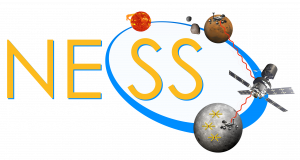What are the limitations of low-frequency radio astronomy on Earth?
As described on the Radio Telescopes page, radio astronomy on Earth faces many challenges. Most importantly, radio waves are used for many parts of daily life, so there are many familiar technologies that operate at the same frequencies at which we wish to observe the spin-flip background. For example, FM radios, television broadcasts, and aircraft and satellite communications channels all interfere with signals from the Cosmic Dawn. A partial solution is to situate radio telescopes in isolated locations – like the Karoo Desert in South Africa, the home of HERA – but even there, meteor trails and other atmospheric phenomena can reflect terrestrial interference toward the telescope! Additionally, the ionosphere, a layer of ionized gas high in Earth’s atmosphere, can block radio waves. This becomes particularly severe for studies of the Dark Ages, where the ionosphere becomes opaque.
Image: FM and TV radio antennas on Sandia Peak near Albuquerque, New Mexico, US.
Credit:
Daniel Mayer, CC BY-SA 3.0, via Wikimedia Commons
Why do radio astronomy from the Moon?
One ambitious way to avoid terrestrial interference and the Earth's ionosphere is to make measurements from space. While astronomers already position many telescopes in Earth orbit, in this case that would actually make the terrestrial interference problem worse, because the radio telescope would simply see radio waves from all of Earth! Instead, we must find a “shield” to block transmission from Earth. There is no better choice than the Moon itself: on its far side, which always faces away from Earth, the Moon itself becomes a powerful and thick shield protecting our radio measurements from contamination. Moreover, the Moon itself lacks an ionosphere.
Image: concept of DAPPER on the moon.
Credit: University of Colorado and Tend Studios
What are the biggest challenges to doing radio astronomy on the Moon?
Radio telescopes are typically quite large: the spin-flip background from the Cosmic Dawn is composed of waves that are several feet (or a few meters) across, and radio telescopes must be at least that large. The biggest challenge is simply assembling these large devices so far from home! Fortunately, NASA’s goal to return to the Moon in the near future is providing many tools for such an effort, including rockets powerful enough to haul the telescopes to the Moon, the infrastructure to communicate with telescopes on the lunar surface, and robotics advanced enough to help deploy the telescopes themselves.
A second challenge is identical to that for telescopes on Earth: the spin-flip background from the Cosmic Dawn is far from the only astronomical source of low-frequency radio waves, and those “foregrounds” are tens of thousands of times brighter than the cosmological signal. Astronomers must devise ways to distinguish the signal they seek from the “noise” of other sources – which requires careful planning and testing of the instruments.
Image: All sky map of 'noisy foreground' radio signals caused by particles orbiting the magnetic field of our galaxy (also called synchrotron radiation).
Credit: NASA / LAMBDA Archive Team
What does the future hold?
NASA is considering several efforts to observe the spin-flip background from (or near) the Moon. The Dark Ages Polarimeter Pathfinder (DAPPER) is a small telescope that would orbit the Moon. When it passes by the Moon’s far side, it would observe the spin-flip background at select frequencies spanning the Dark Ages and Cosmic Dawn. Because it is a small telescope, it would observe the average spin-flip background, measuring how the Universe evolved on a global scale through these periods. A more complex mission concept, the Dark Ages Radio Explorer (DARE) would measure this with even more detail.
Image: Artist illustration of the Dark Ages Polarimetry Pathfinder (DAPPER), which will look for faint radio signals from the early universe while operating in a low lunar orbit.
Credit: NRAO/AUI/NSF, Sophia Dagnello
FARSIDE is an even more ambitious mission, which involves the construction of an array of radio antennae on the lunar surface, distributed around an area of several square miles! The antennae would be deployed using robotic rovers. Detecting signals from the Cosmic Dawn will be very difficult, but early versions of the array hope to observe radio emission from the Sun and even from nearby exoplanets.
Image: Concept of FARSIDE: A Low Radio Frequency Interferometric Array on the Lunar Farside
Credit: Courtesy of Blue Origin
While these instruments are still in the planning stages, NASA is already taking first steps toward doing radio astronomy from the Moon. The Lunar Surface Electromagnetic Experiment (LuSEE) and the Radio Observations at the Lunar Surface of the photoelectron Sheath (ROLSES) will study the lunar environment, aiding our understanding of future projects.
Image: Concept of the Lunar Surface Electromagnetics Experiment (LuSEE), which will study the magnetic and electric fields on the moon’s surface.
Credit: NASA NESS


